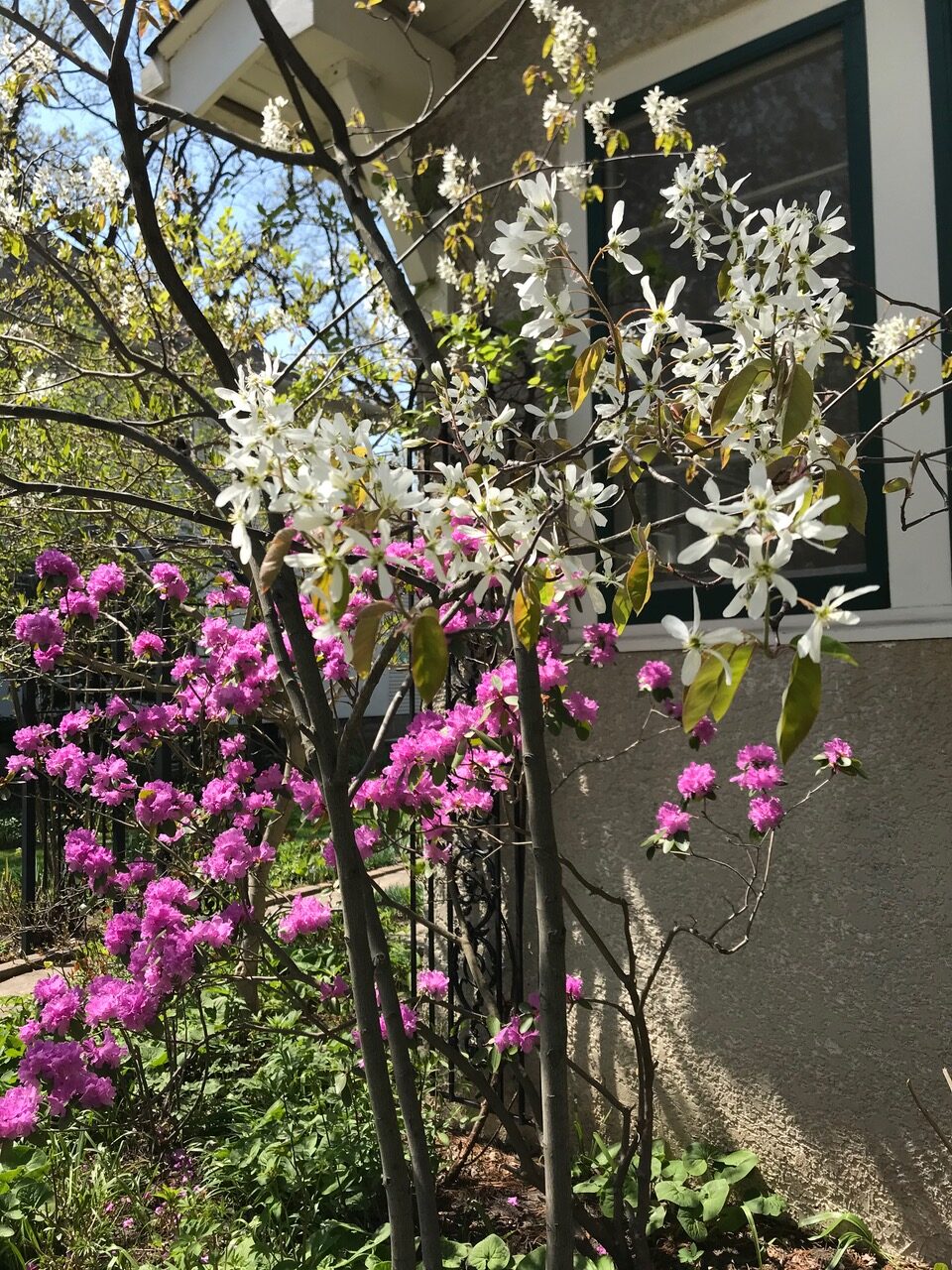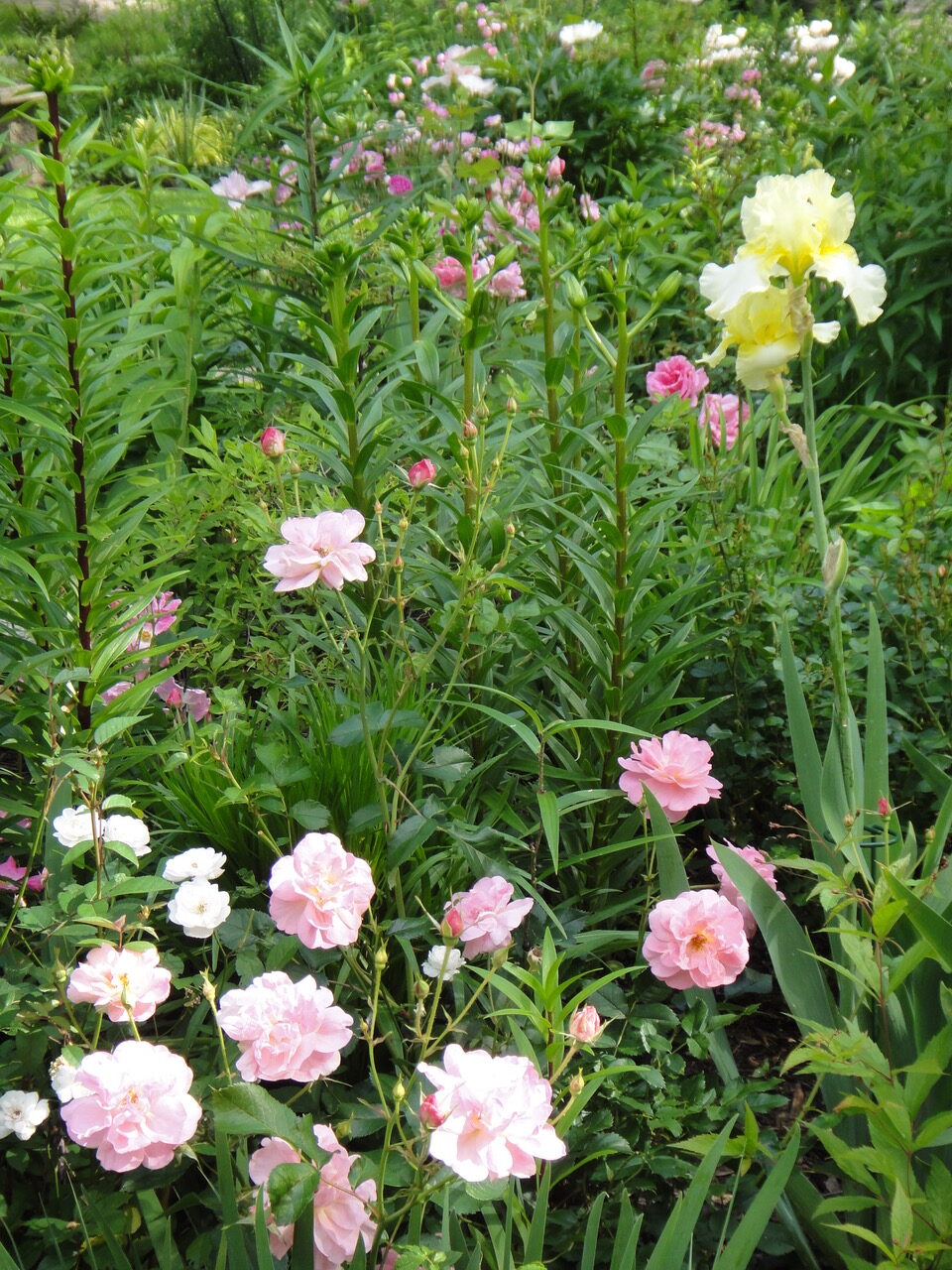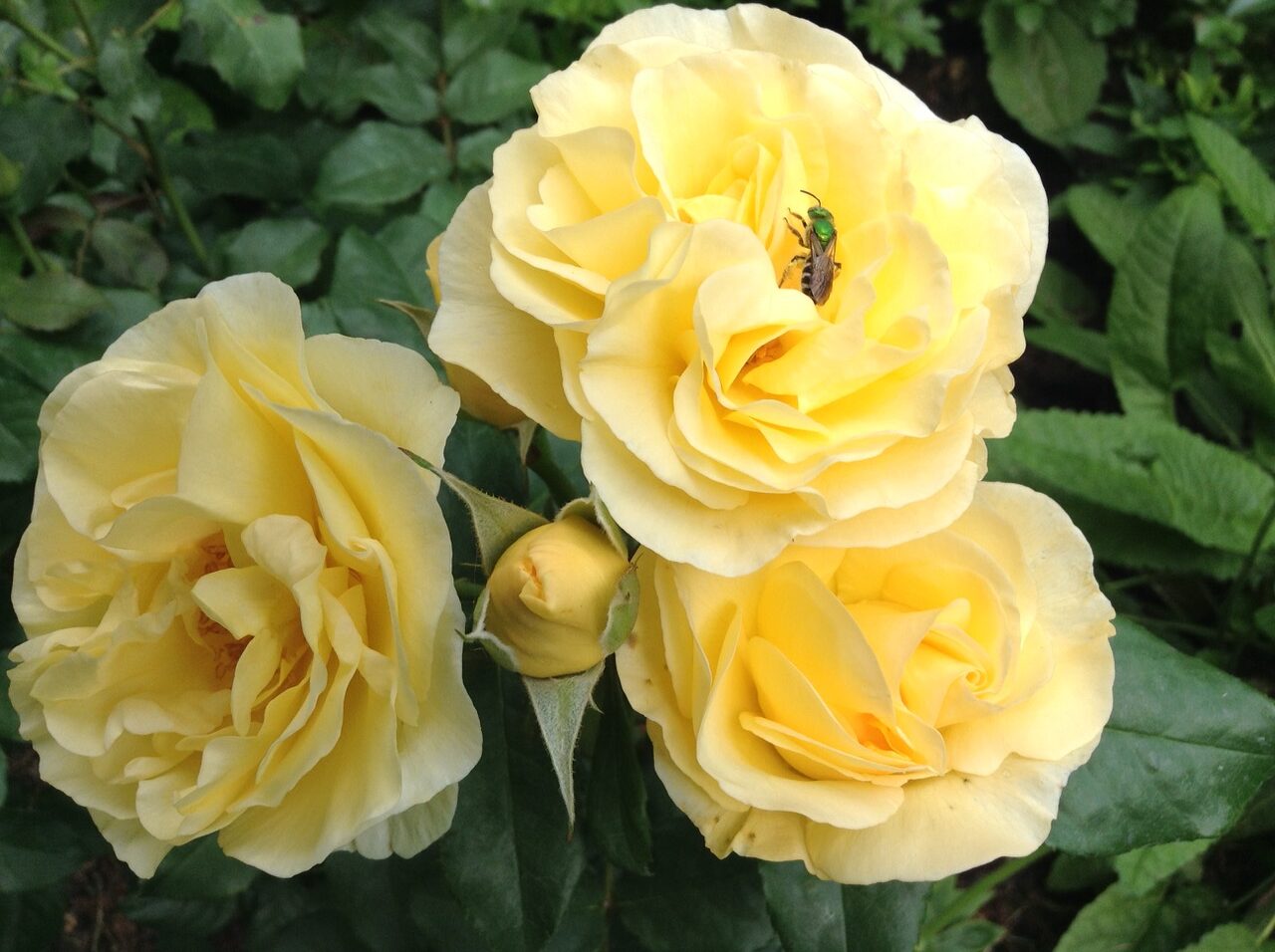Today’s photos are from Susan Warde of St. Paul, Minnesota (Zone 4b).
The rose family (Rosaceae) provides us with numerous beautiful plants besides just the rose species. Here are a few examples from my garden.
 This puff of cotton candy, queen-of-the-prairie (Filipendula rubra, Zones 3–8), was on the property when we bought our house. Its weedy-looking foliage seemed unpromising, but one year it flowered and I moved it to where it now does (all too) well.
This puff of cotton candy, queen-of-the-prairie (Filipendula rubra, Zones 3–8), was on the property when we bought our house. Its weedy-looking foliage seemed unpromising, but one year it flowered and I moved it to where it now does (all too) well.
 Bridal wreath (Spirea prunifolia, Zones 5–8) is an old-fashioned favorite. I remember it from the 1940s frothing around my grandmother’s veranda. This specimen anchors the corner of the front yard and performs respectably in spite of getting little sun. The lime-green ferns below it are the native sensitive fern (Onoclea sensibilis, Zones 4–9).
Bridal wreath (Spirea prunifolia, Zones 5–8) is an old-fashioned favorite. I remember it from the 1940s frothing around my grandmother’s veranda. This specimen anchors the corner of the front yard and performs respectably in spite of getting little sun. The lime-green ferns below it are the native sensitive fern (Onoclea sensibilis, Zones 4–9).
 I have three of these ‘Red Splendor’ crabapples (Malus ‘Red Splendor’, Zones 4–8), which I got after admiring them many years ago on the University of Minnesota campus near us. Though glorious in the spring, this cultivar is huge (at least 40 feet tall) and is susceptible to apple scab. I don’t recommend it!
I have three of these ‘Red Splendor’ crabapples (Malus ‘Red Splendor’, Zones 4–8), which I got after admiring them many years ago on the University of Minnesota campus near us. Though glorious in the spring, this cultivar is huge (at least 40 feet tall) and is susceptible to apple scab. I don’t recommend it!
 Ash leaf spirea (Sorbaria sorbarifolia, Zones 2–11) bears clusters of tiny white flowers if it gets enough sun, but I grow it for its foliage, which emerges salmon and gold early in the season. It’s a spreader but digs up easily (and even transplants well).
Ash leaf spirea (Sorbaria sorbarifolia, Zones 2–11) bears clusters of tiny white flowers if it gets enough sun, but I grow it for its foliage, which emerges salmon and gold early in the season. It’s a spreader but digs up easily (and even transplants well).
 Lady’s mantle (Alchemilla mollis, Zones 3–8) is another member of the rose family with interesting foliage. The leaves feel soft like flannel, and tiny hairs catch water droplets that bead up prettily. The clusters of chartreuse flowers attract pollinators.
Lady’s mantle (Alchemilla mollis, Zones 3–8) is another member of the rose family with interesting foliage. The leaves feel soft like flannel, and tiny hairs catch water droplets that bead up prettily. The clusters of chartreuse flowers attract pollinators.
 Serviceberry ‘Autumn Brilliance’ (Amelanchier × grandiflora, Zones 4–9) has white flowers that last, if you’re lucky, about three days. These are followed by blue berries that are edible—unless squirrels or chipmunks or birds get to them first. A graceful small tree with gray bark, it really comes into its own in the fall, as its cultivar name suggests. The burst of pinky-purple is a PJM Rhododendron (Zones 4–8).
Serviceberry ‘Autumn Brilliance’ (Amelanchier × grandiflora, Zones 4–9) has white flowers that last, if you’re lucky, about three days. These are followed by blue berries that are edible—unless squirrels or chipmunks or birds get to them first. A graceful small tree with gray bark, it really comes into its own in the fall, as its cultivar name suggests. The burst of pinky-purple is a PJM Rhododendron (Zones 4–8).
 Unlike the serviceberry’s blossoms, those of pearl bush (Exochorda × macrantha, Zones 3–7) are long lasting, though the fruits are negligible. If you look carefully you can see a few unopened buds, the “pearls” that give this shrub its common name. I believe this particular cultivar is ‘Lotus Moon.’ Bees go crazy for it.
Unlike the serviceberry’s blossoms, those of pearl bush (Exochorda × macrantha, Zones 3–7) are long lasting, though the fruits are negligible. If you look carefully you can see a few unopened buds, the “pearls” that give this shrub its common name. I believe this particular cultivar is ‘Lotus Moon.’ Bees go crazy for it.
 I have had some true roses, however. Unwilling to bother with the “Minnesota tip” for hybrid teas (you bend the canes over and bury them for the winter), I didn’t begin collecting roses until a fine selection of hardy shrub roses made their appearance, and I acquired quite of few of them.
I have had some true roses, however. Unwilling to bother with the “Minnesota tip” for hybrid teas (you bend the canes over and bury them for the winter), I didn’t begin collecting roses until a fine selection of hardy shrub roses made their appearance, and I acquired quite of few of them.
 Another cherished rebloomer was the luscious yellow ‘High Voltage.’ But increasing shade and then the arrival of Japanese beetles in the state made growing roses successfully too challenging for me. The beetles especially loved this rose. I’d see an exquisite blossom begin to unfurl early in the morning, and by midday it would be a mess of shredded and frass-covered petals.
Another cherished rebloomer was the luscious yellow ‘High Voltage.’ But increasing shade and then the arrival of Japanese beetles in the state made growing roses successfully too challenging for me. The beetles especially loved this rose. I’d see an exquisite blossom begin to unfurl early in the morning, and by midday it would be a mess of shredded and frass-covered petals.
 I now have only one remaining rose, ‘William Baffin’ (Zones 3–9). It’s a climber (more of a leaner, actually—mine is supported by a wrought-iron arbor). Developed in Canada, it’s one of the hardiest of the Explorer series. Desperate rabbits chew on it during the winter months in spite of its wicked thorns. The first flush of blooms usually occurs before the Japanese beetles emerge.
I now have only one remaining rose, ‘William Baffin’ (Zones 3–9). It’s a climber (more of a leaner, actually—mine is supported by a wrought-iron arbor). Developed in Canada, it’s one of the hardiest of the Explorer series. Desperate rabbits chew on it during the winter months in spite of its wicked thorns. The first flush of blooms usually occurs before the Japanese beetles emerge.
Have a garden you’d like to share?
Have photos to share? We’d love to see your garden, a particular collection of plants you love, or a wonderful garden you had the chance to visit!
To submit, send 5-10 photos to [email protected] along with some information about the plants in the pictures and where you took the photos. We’d love to hear where you are located, how long you’ve been gardening, successes you are proud of, failures you learned from, hopes for the future, favorite plants, or funny stories from your garden.
Have a mobile phone? Tag your photos on Facebook, Instagram or Twitter with #FineGardening!
Do you receive the GPOD by email yet? Sign up here.
